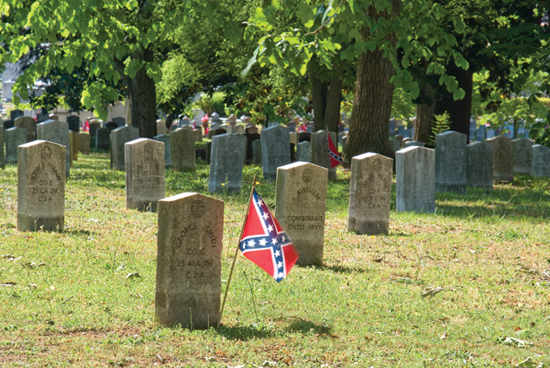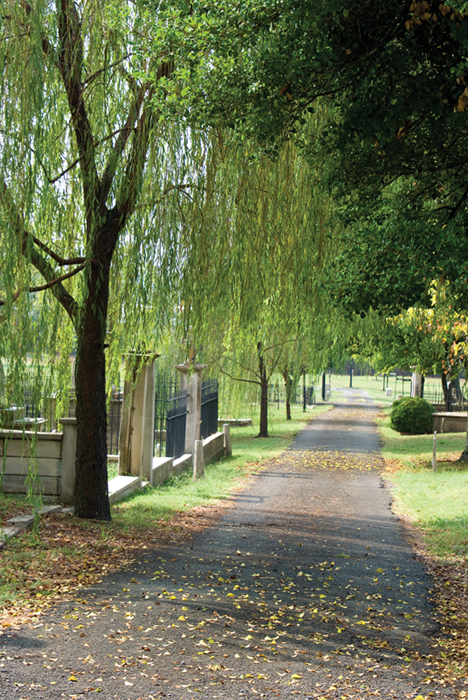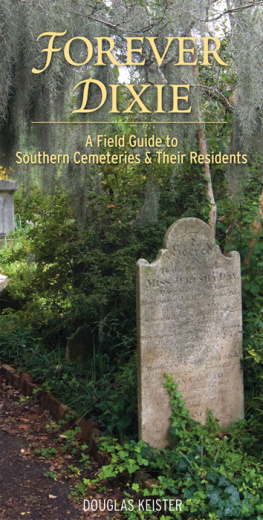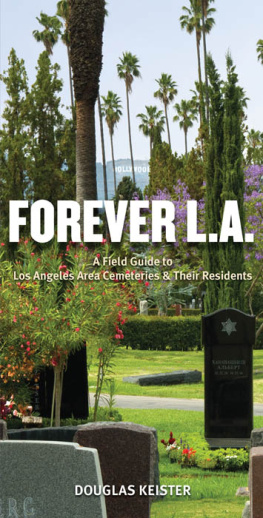Keister - Forever Dixie
Here you can read online Keister - Forever Dixie full text of the book (entire story) in english for free. Download pdf and epub, get meaning, cover and reviews about this ebook. year: 2008, publisher: Gibbs Smith, genre: Romance novel. Description of the work, (preface) as well as reviews are available. Best literature library LitArk.com created for fans of good reading and offers a wide selection of genres:
Romance novel
Science fiction
Adventure
Detective
Science
History
Home and family
Prose
Art
Politics
Computer
Non-fiction
Religion
Business
Children
Humor
Choose a favorite category and find really read worthwhile books. Enjoy immersion in the world of imagination, feel the emotions of the characters or learn something new for yourself, make an fascinating discovery.
- Book:Forever Dixie
- Author:
- Publisher:Gibbs Smith
- Genre:
- Year:2008
- Rating:4 / 5
- Favourites:Add to favourites
- Your mark:
- 80
- 1
- 2
- 3
- 4
- 5
Forever Dixie: summary, description and annotation
We offer to read an annotation, description, summary or preface (depends on what the author of the book "Forever Dixie" wrote himself). If you haven't found the necessary information about the book — write in the comments, we will try to find it.
Keister: author's other books
Who wrote Forever Dixie? Find out the surname, the name of the author of the book and a list of all author's works by series.
Forever Dixie — read online for free the complete book (whole text) full work
Below is the text of the book, divided by pages. System saving the place of the last page read, allows you to conveniently read the book "Forever Dixie" online for free, without having to search again every time where you left off. Put a bookmark, and you can go to the page where you finished reading at any time.
Font size:
Interval:
Bookmark:

Forever Dixie
Digital Edition v1.0
Text 2008 Douglas Keister
Photographs 2008 Douglas Keister
All rights reserved. No part of this book may be reproduced by any means whatsoever without written permission from the publisher, except brief portions quoted for purpose of review.
Gibbs Smith, Publisher
PO Box 667
Layton, UT 84041
Orders: 1.800.835.4993
www.gibbs-smith.com
Library of Congress Catalog-in-Publishing Data
ISBN-13: 978-1-4236-0314-6
ISBN-10: 1-4236-0314-1
1. CemeteriesSouthern StatesGuidebooks. 2. Sepulchral monumentsSouthern StatesGuidebooks. 3. Southern StatesBiography. 4. Southern StatesGenealogy. I. Title.
F210.K35 2008
929.50975dc22
2008012366
To Sandy, Forever
There are few words that are as emotionally charged as Dixie. Depending on the audience and venue, Dixie can evoke warm feelings of hearth, home, patriotism, and remembrance, or bristly feelings of segregation, prejudice, arrogance, and exclusion. The word Dixie first came into popular language when northerner Daniel Emmett published the song I Wish I Was in Dixies Land on June 21, 1860. The song has since been published under the title Dixie and Dixies Land. The name Dixie may have come from privately issued ten dollar notes in Louisiana known as dixes (the French word for ten). Other theories refer to the Mason-Dixon Line and a purportedly kind New York slave owner, Mr. Dixy.
Nowadays, Dixie is attached to a variety of things. There are Dixie Chicks, Dixie Cups (invented by a Bostonian), Winn-Dixie supermarkets, Dixieland Jazz bands, Dixiecrats (a portmanteau of fiercely Southern politicians and Democrats), Dixie National Forest and Dixie State College (in southern Utah), and a multitude of brands and services.

Confederate Section, Oakland Cemetery, Atlanta, Georgia.
The geographic borders of Dixie are hard to pin down. Most scholars agree that all of the states in the Deep South are part of Dixie, but even those scholars cant agree on what comprises the Deep South. For the purpose of this book, weve placed the center of Dixie in northwestern Alabama and drawn a very wavy line around it. Weve only included states where almost all of the state has a Southern feel. Thus, we havent included Florida, the state that has the southernmost point in the continental United States. In fact, the farther south one goes in Florida, the more northern it seems to become. Wander into a grocery store in Miami Beach and youre likely to find hush puppy mix in the exotic foods section. Another geographically southern state is Texas, but large parts of the Lone Star State are decidedly western in flavor; youre more likely to find refried beans than black-eyed peas on the menu in El Paso. Missouri is another conundrum; although parts of it are definitely Southern (Dred Scott is buried in Bellefontaine Cemetery in St. Louis), most of Missouri stretches too far north. What you will find in this book are the solidly Southern states of Virginia (Richmond was the capital of the Confederacy), North Carolina, South Carolina, Georgia, Alabama, Mississippi, Louisiana, Arkansas, Tennessee, and Kentucky (that quintessential southern gentleman Col. Harland Sanders is buried in Louisvilles Cave Hill Cemetery).
Ultimately, Dixie is not defined so much as a geographic area as by the heart and soul of its people. Although we cant possibly include every cemetery and every notable Southerner in this modest tome, we have tried to capture the spirit of Dixiea spirit best summed up in words penned 150 years ago by a Yankee:
I wish I was in the land of cotton,
old times there are not forgotten,
Look away, look away, look away, Dixie Land.
In Dixie Land where I was born in,
early on a frosty mornin,
Look away, look away, look away, Dixie Land.
Chorus:
Then, I wish I was in Dixie,
hooray! hooray!
In Dixie Land Ill take my stand
to live and die in Dixie
Away, away, away down South in Dixie,
Away, away, away down South in Dixie.
Note: Global Positioning System (GPS) coordinates are given to almost all of the graves and cemeteries. There are at least four ways GPS coordinates are displayed. We have chosen to use the one most often used in automotive devices. Converters for the other types of GPS coordinates are available on the Internet. The GPS directions to the entrances and not the graves of the smaller cemeteries are given since the cemeteries are best explored by walking rather than driving and individual graves are easy to locate. Most larger cemeteries have maps available in their office for free or a nominal charge. Many historic cemeteries are essentially full and rely on grants, donations, and the work of volunteers through Friends of organizations. Please support them in any way you can. They are preserving an important part of American history.
About Dixie

Nashville City Cemetery, Nashville, Tennessee
In the United States, we tend to call all of our burying grounds cemeteries. In fact, there are a number of different types of burying grounds that often overlap each other.
The first formal burying grounds were graveyards located in newly formed municipalities. One of the facts of life is death, and after death the body needed to be disposed. These early graveyards were often little more than garbage dumps with a few haphazard wooden grave markers or gravestones for those souls lucky enough to have a family that could afford one. As time went on, some city graveyards became better organized because city fathers were concerned about how they looked and also about health concerns that arose out of less-than-hygenic burial practices.
In Colonial America, most folks belonged to some sort of church, and most churches provided burial space for their parishioners. Generally the churchyard, also known as Gods Acre, surrounded the church and, unlike early graveyards, provided a bit more opportunity to erect elaborate and more-or-less permanent memorials to the dead. Although simple tablet gravestones dominate churchyards, there are often a number of specialized tombs, sarcophagi, and sculptures.
A profound change in Americas burial grounds occurred in the early nineteenth century with the formation of the first cemeteries. The word cemetery comes from the Greek koimeterion, dormitory (a room for sleeping), via the Latin coemeterium. Although the word appears as early as the fourteenth century, it didnt come into common use in America until the advent of the garden cemetery. Garden cemeteries (sometimes called rural cemeteries) in America can trace their roots to Cimetire du Pre-Lachaise in Paris, France. Pre-Lachaise was founded in 1804 in response to the overcrowding in Pariss municipal cemeteries. Pre-Lachaise was modeled on English estate landscape design and was intended to provide a more bucolic environment for tending the dead. American burying grounds soon followed suit with the establishment in 1831 of Mount Auburn Cemetery in Cambridge, Massachusetts, as Americas first garden cemetery. Except for the tombstones, monuments, and mausoleums, garden cemeteries (with their lush plantings and groomed landscaping) look more like public parks than burying grounds.
Font size:
Interval:
Bookmark:
Similar books «Forever Dixie»
Look at similar books to Forever Dixie. We have selected literature similar in name and meaning in the hope of providing readers with more options to find new, interesting, not yet read works.
Discussion, reviews of the book Forever Dixie and just readers' own opinions. Leave your comments, write what you think about the work, its meaning or the main characters. Specify what exactly you liked and what you didn't like, and why you think so.












